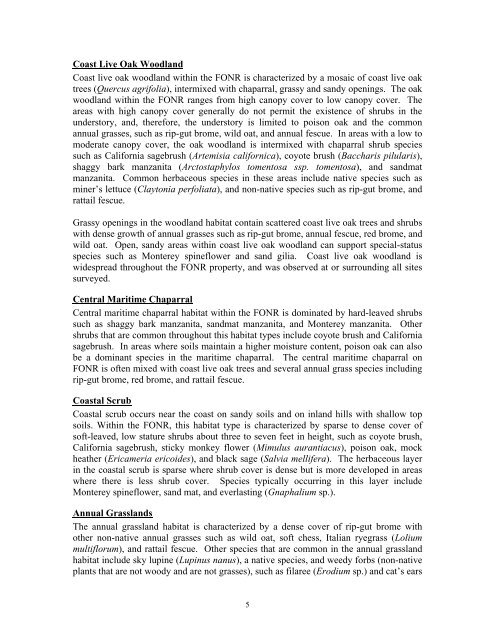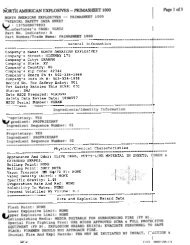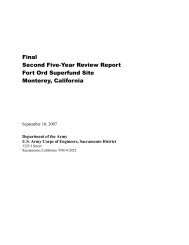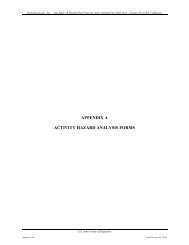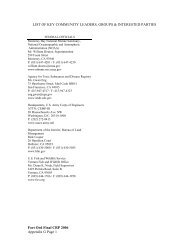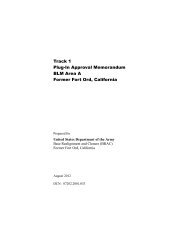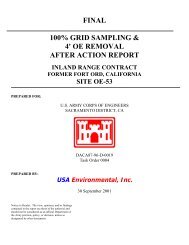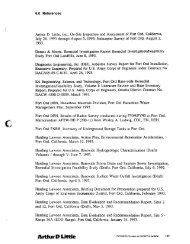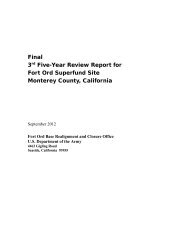APPENDIX A 2008 RARE PLANT AND HABITAT SURVEY RESULTS
APPENDIX A 2008 RARE PLANT AND HABITAT SURVEY RESULTS
APPENDIX A 2008 RARE PLANT AND HABITAT SURVEY RESULTS
You also want an ePaper? Increase the reach of your titles
YUMPU automatically turns print PDFs into web optimized ePapers that Google loves.
Coast Live Oak Woodland<br />
Coast live oak woodland within the FONR is characterized by a mosaic of coast live oak<br />
trees (Quercus agrifolia), intermixed with chaparral, grassy and sandy openings. The oak<br />
woodland within the FONR ranges from high canopy cover to low canopy cover. The<br />
areas with high canopy cover generally do not permit the existence of shrubs in the<br />
understory, and, therefore, the understory is limited to poison oak and the common<br />
annual grasses, such as rip-gut brome, wild oat, and annual fescue. In areas with a low to<br />
moderate canopy cover, the oak woodland is intermixed with chaparral shrub species<br />
such as California sagebrush (Artemisia californica), coyote brush (Baccharis pilularis),<br />
shaggy bark manzanita (Arctostaphylos tomentosa ssp. tomentosa), and sandmat<br />
manzanita. Common herbaceous species in these areas include native species such as<br />
miner’s lettuce (Claytonia perfoliata), and non-native species such as rip-gut brome, and<br />
rattail fescue.<br />
Grassy openings in the woodland habitat contain scattered coast live oak trees and shrubs<br />
with dense growth of annual grasses such as rip-gut brome, annual fescue, red brome, and<br />
wild oat. Open, sandy areas within coast live oak woodland can support special-status<br />
species such as Monterey spineflower and sand gilia. Coast live oak woodland is<br />
widespread throughout the FONR property, and was observed at or surrounding all sites<br />
surveyed.<br />
Central Maritime Chaparral<br />
Central maritime chaparral habitat within the FONR is dominated by hard-leaved shrubs<br />
such as shaggy bark manzanita, sandmat manzanita, and Monterey manzanita. Other<br />
shrubs that are common throughout this habitat types include coyote brush and California<br />
sagebrush. In areas where soils maintain a higher moisture content, poison oak can also<br />
be a dominant species in the maritime chaparral. The central maritime chaparral on<br />
FONR is often mixed with coast live oak trees and several annual grass species including<br />
rip-gut brome, red brome, and rattail fescue.<br />
Coastal Scrub<br />
Coastal scrub occurs near the coast on sandy soils and on inland hills with shallow top<br />
soils. Within the FONR, this habitat type is characterized by sparse to dense cover of<br />
soft-leaved, low stature shrubs about three to seven feet in height, such as coyote brush,<br />
California sagebrush, sticky monkey flower (Mimulus aurantiacus), poison oak, mock<br />
heather (Ericameria ericoides), and black sage (Salvia mellifera). The herbaceous layer<br />
in the coastal scrub is sparse where shrub cover is dense but is more developed in areas<br />
where there is less shrub cover. Species typically occurring in this layer include<br />
Monterey spineflower, sand mat, and everlasting (Gnaphalium sp.).<br />
Annual Grasslands<br />
The annual grassland habitat is characterized by a dense cover of rip-gut brome with<br />
other non-native annual grasses such as wild oat, soft chess, Italian ryegrass (Lolium<br />
multiflorum), and rattail fescue. Other species that are common in the annual grassland<br />
habitat include sky lupine (Lupinus nanus), a native species, and weedy forbs (non-native<br />
plants that are not woody and are not grasses), such as filaree (Erodium sp.) and cat’s ears<br />
5


